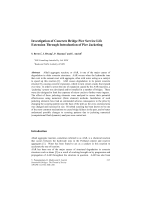Bridges

- Publication no: ABC-MAR008-11
- Published: 31 October 2011
- PDF (free) Download
Alkali aggregate reaction, or AAR, is one of the major causes of degradation in older concrete structures. AAR occurs when the hydroxide ions that exist in the cement react with aggregate, often with water acting as a catalyst to speed up this reaction. AAR causes degradation in its parent concrete structure by causing concrete expansion, which in turn creates cracks that expand over time. In order to arrest the rate of expansion caused by the AAR reactions, a ‘jacketing’ system was developed and/or installed in a number of bridges. These were also designed to limit the exposure of micro cracks to further water ingress. The effect of these jacketing elements were analysed to assess their potential effectiveness using numerical (finite element) methods. Installation of such jacketing elements have had an unintended adverse consequence to the piles by changing the scouring pattern near the base of the piles as the cross sectional area was changed and increased in size. Riverbed scouring has been known to be one of the most common mechanisms to cause bridge failures in the past, and to better understand possible changes to scouring patterns due to jacketing numerical (computational fluid dynamics) analyses were carried out.
